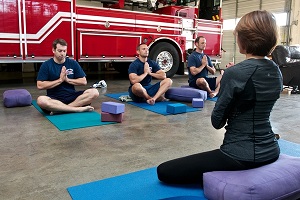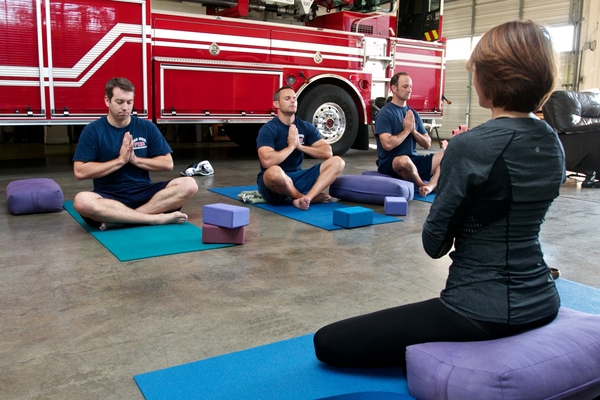

By Shannon McQuaide
In little more than 2½ years, a tiny pilot yoga program for six bold firefighters has expanded to include more than 100 firefighters throughout the San Francisco Bay Area. Why is yoga in fire stations growing so quickly given that, on the surface, yoga seems like the antithesis of firefighting?
The assumption among many firefighters is that yoga is soft, feminine, and gentle–that it promotes flexibility but not strength. But this assumption is misinformed. While developing flexibility is certainly an aspect of yoga, it’s just one branch of a tree that has many limbs. Building strength and resilience and promoting moderation in all aspects of life are also key branches of yoga practice. Now that I’ve spent considerable time teaching yoga in fire stations, I see very clearly the striking similarities between the firefighter and yoga cultures. I believe the reason firefighters are embracing yoga with such enthusiasm has as much to do with these similarities as it does with the physical and psychological relief yoga provides.
The main branches of yoga include ethical guidelines, postures, breathing exercises, meditation, and the quest for liberation. The ethical principles prescribe behaviors and attitudes that promote community, cooperation, ease, contentment, happiness, and moderation. These principles make up the root, the foundation of yoga.
Similarly, most fire departments have written mission statements and codes of ethics that support firefighters in being disciplined and respectful, in not bringing harm to their departments and communities and to themselves. These principles make up the foundation of the profession. They are designed so firefighters can enjoy long, healthy, and successful careers. This is from the Web site of one of the fire departments where I teach yoga:
NFD Members are: • Always helpful, respectful, and nice to each other and the public • Smart, skilled, productive, and self disciplined • Inquisitive but respectful in their demeanor • Committed, accountable, loyal, cooperative, and team players • Healthy and physically fit • Appreciative of NFD benefits, members, and the NFD Community • Positive, constructive, supportive, and forgiving
Sounds a lot like the principles of yoga! However, there is one prescribed behavior within the yoga culture that I think is particularly hard to follow inside the fire service: the practice of moderation. Moderation as a practice is often described with negative language, and we think it means having to restrain ourselves and put limitations on the things we like to do. Using more positive language, however, moderation can mean taking care of ourselves. Applying moderation as a practice inside the fire service may look like how to moderate or manage energy during 24-or 48-hour shifts or how to channel and distribute energy during prolonged periods of physical and psychological stress. Practicing moderation can mean the difference between feeling like you have some gas left in the tank to interact with family and friends during your off duty time as opposed to feeling burnt out, exhausted, and emotionally shut down.
Process vs. Product
To help firefighters find moderation during yoga practice, I offer some alternate ways of thinking about fitness. Rather than using yoga as a means to an end, I suggest thinking about yoga as a process that continues to evolve over time, often not in a linear fashion. This approach requires a different kind of attitude than the one I commonly see in fire departments—no pain no gain. While this attitude might work for short-term results, it’s dangerous when applied over the long span of a career. My yoga teacher uses the following phrase to capture a process-oriented attitude: “It’s not how far you go, but how you go.” Vince Lombardi, legendary coach for the Green Bay Packers, said it best: “The journey is the reward.”
Another important process-oriented attitude toward yoga is explained as playing our edge. To play our edge means to explore and respect our physical limitations on any given day. We can see this idea more clearly when juxtaposed with a more product-oriented approach. It’s mind over matter. When we practice yoga, we don’t ignore or push through pain, contort our bodies into shapes that they were never intended to do. Rather, I encourage firefighters to notice their edges by paying attention to those places where they experience resistance, especially in the muscles or joints. This resistance can be thought of as an edge. Instead of pushing ahead or pulling back, firefighters are learning to stay present and explore how their bodies respond after a few moments of careful attention. Over time, which may be a moment, a day, or a year, their bodies will incrementally open to new and previously unexplored edges.
And while a process vs. product attitude is important during yoga practice, it also translates into what firefighters do every day. The following story from the captain of the San Jose (CA)m Fire Department is just one of the many from firefighters describing how yoga is helping them regulate their energy and enhance performance:
“When I’m at work and get a call, the first thing I do is listen to the information from the dispatcher and try to formulate a picture in my mind about the situation, what it looks like, and what we will need to do when we get there. I keep listening to the information as I pull on my turnouts, jump into the captain’s seat, and put on the headset. Before I give the engineer the signal to pull out, I take deep a breath and clear my mind of everything not related to the call. I have found that just taking a few deep breaths before I move helps me to do a much better job of formulating and executing a plan.”
If there’s one thing I know about the firefighters I work with, they are conscientious people. When the bell sounds and someone is in need of assistance, firefighters will do what it takes to provide that assistance, and they will do a great job. It’s part of their code of ethics. But what yoga is teaching firefighters is how to examine their attitude or approach to their work so that when that call or shift is complete, they still have energy for the next call—or for the next 10 years of calls.
 Shannon McQuaide is a registered yoga instructor with Yoga Alliance and the founder of the FireFLEX YogaTM program. FireFLEX Yoga was developed through her work with the San Jose (CA) Fire Department, where she continues to lead FireFLEX Yoga classes. She is a certified functional movement trainer and has a master of arts degree in leadership and psychology. Shannon@fireflexyoga.com http://www.fireflexyoga.com.
Shannon McQuaide is a registered yoga instructor with Yoga Alliance and the founder of the FireFLEX YogaTM program. FireFLEX Yoga was developed through her work with the San Jose (CA) Fire Department, where she continues to lead FireFLEX Yoga classes. She is a certified functional movement trainer and has a master of arts degree in leadership and psychology. Shannon@fireflexyoga.com http://www.fireflexyoga.com.

